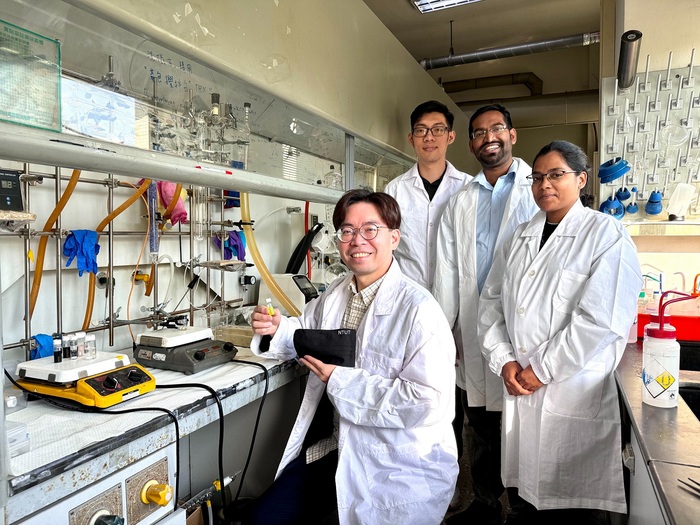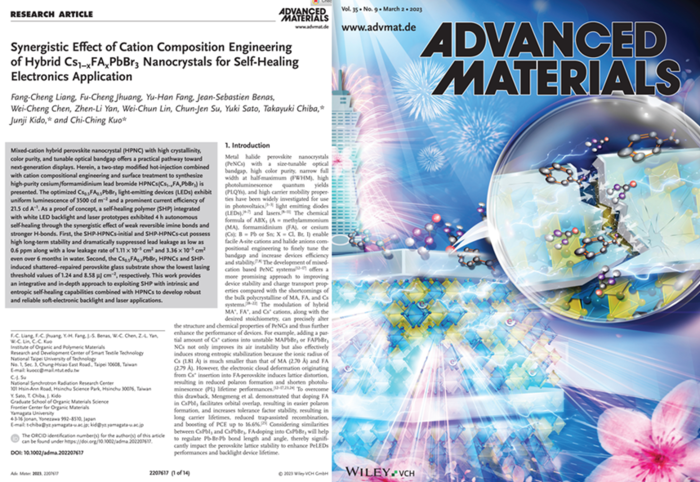Taipei Tech's Collaborative International Research with the U.S. and Japan Featured in Renowned Academic Journals


Taipei Tech's Professor Kuo Chi-Ching, PhD candidate Archana Pandiyan, and Assistant Professor of Research Loganathan Veeramuthu from the Department of Molecular Science and Engineering, along with Assistant Professor Tao Zhou from Penn State University, co-authored an article titled "A Comprehensive Review on Perovskite and Its Functional Composites in Smart Textiles: Progress, Challenges, Opportunities, and Future Directions." This article, published in the internationally renowned journal Progress in Materials Science, highlights the potential of durable and environmentally-friendly Perovskite composites.
Kuo indicated that Perovskite has become the most promising low-cost energy material for applications in optoelectronic components. Collaborating with Taipei Tech’s Smart Textile Technology Research Center, the research team began the research journey by studying the application of Perovskite composite materials in textiles, such as nano fibers, light-emitting textiles, sensor patch, and wound dressing. Kuo noted the continuous evolution in clothing materials, emphasizing their enhanced functionalities such as improved warmth, cooling, wind resistance, breathability, and waterproofing. He highlighted that the potential application of Perovskite in functional fibers could revolutionize the way we use clothing by converting the kinetic energy generated by body movement into electrical energy, which can then be stored for various uses.
Moreover, the research between Kuo and the research team of Professor Junji Kido from the University of Yamagata, Japan was featured as the cover story in the prestigious international journal Advanced Materials. The article, titled “Synergistic Effect of Cation Composition Engineering of Hybrid Cs1−xFAxPbBr3 Nanocrystals for Self-Healing Electronics Application,” explores the innovative integration of Perovskite with self-healing materials. This groundbreaking work has garnered significant attention in the global academic community, marking a remarkable achievement in the field.
Kuo explained that Perovskite elements are typically used for their electrical conductivity and light-emitting properties in solar batteries, LED, and optical memory devices. However, their quick degradation from water and oxygen exposure can diminish their optoelectronic capabilities. Kuo and the research team developed a self-healing high molecular polymer that encapsulates Perovskite, enhancing not only its durability but also its environmental friendliness. The technique has been patented.
Encapsulating Perovskite took four years of rigorous research work. Students were sent to Japan to study the quantum dots that produce the purest Perovskite with the highest light-emitting efficiency. The research team followed up with inventing and combining self-healing high molecular materials with such Perovskite. The research team also developed reliable self-healing electronic component that can be applied to produce high-performing micro-LED display and laser devices.
Kuo indicated that Perovskite has become the most promising low-cost energy material for applications in optoelectronic components. Collaborating with Taipei Tech’s Smart Textile Technology Research Center, the research team began the research journey by studying the application of Perovskite composite materials in textiles, such as nano fibers, light-emitting textiles, sensor patch, and wound dressing. Kuo noted the continuous evolution in clothing materials, emphasizing their enhanced functionalities such as improved warmth, cooling, wind resistance, breathability, and waterproofing. He highlighted that the potential application of Perovskite in functional fibers could revolutionize the way we use clothing by converting the kinetic energy generated by body movement into electrical energy, which can then be stored for various uses.
Moreover, the research between Kuo and the research team of Professor Junji Kido from the University of Yamagata, Japan was featured as the cover story in the prestigious international journal Advanced Materials. The article, titled “Synergistic Effect of Cation Composition Engineering of Hybrid Cs1−xFAxPbBr3 Nanocrystals for Self-Healing Electronics Application,” explores the innovative integration of Perovskite with self-healing materials. This groundbreaking work has garnered significant attention in the global academic community, marking a remarkable achievement in the field.
Kuo explained that Perovskite elements are typically used for their electrical conductivity and light-emitting properties in solar batteries, LED, and optical memory devices. However, their quick degradation from water and oxygen exposure can diminish their optoelectronic capabilities. Kuo and the research team developed a self-healing high molecular polymer that encapsulates Perovskite, enhancing not only its durability but also its environmental friendliness. The technique has been patented.
Encapsulating Perovskite took four years of rigorous research work. Students were sent to Japan to study the quantum dots that produce the purest Perovskite with the highest light-emitting efficiency. The research team followed up with inventing and combining self-healing high molecular materials with such Perovskite. The research team also developed reliable self-healing electronic component that can be applied to produce high-performing micro-LED display and laser devices.






